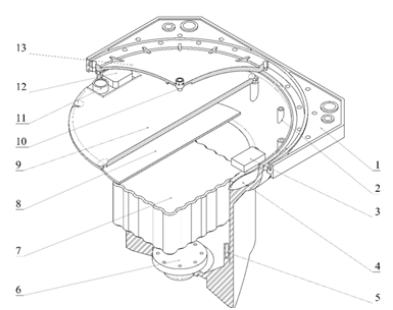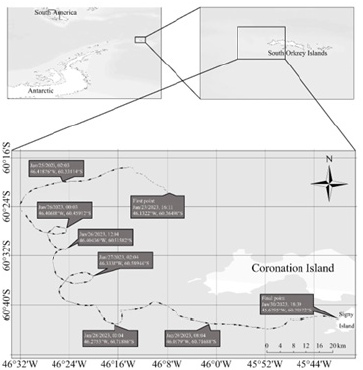- Submissions

Full Text
Examines in Marine Biology & Oceanography
Design and Experiment of Drifting Buoy for Antarctic Krill Swarm Detection
Yang Dai1,2*, Ruilin He2,3, Lin Wei4, Siyi Liu4, Hanfeng Zheng1,2, Yingdong Wang4, Yuhao Yang2,3, Bo Wei2, Wei Fan2 and Shengmao Zhang2
1Laoshan Laboratory, China
2East China Sea Fisheries Research Institute, Chinese Academy of Fishery Sciences, Key Laboratory of Fisheries Remote Sensing Ministry of Agriculture and Rural Affairs, China
3School of Navigation and Naval Architecture, China
4BeiDou Application & Research Institute Co., Ltd. of Norinco Group, China
*Corresponding author: Yang Dai, East China Sea Fisheries Research Institute, Chinese Academy of Fishery Sciences, Key Laboratory of Fisheries Remote Sensing Ministry of Agriculture and Rural Affairs, Shanghai 200090, China
Submission: February 17, 2023;Published: February 28, 2023

ISSN 2578-031X Volume5 Issue4
Abstract
Fish finders are wildly used in fishery, fish stock assessment, and fish behavior research. Satellite fishfinding buoy can be used to assess fishery resource in a particular area with a long-term unattended work. We designed a drifting buoy for krill swarm detection, and released at west of South Orkney Islands, Subarea 48.2. The buoy worked normally for 7 days 2 hours and sent back 157 sets of valid data before offline. It was the first fish-finding drifting buoy for Antarctic Krill, and the data it sent back is valuable for us to improve our further design.
Keywords: Drifting buoy; Fish finder; Antarctic krill; Fish stock assessment; Satellite communication
Abbreviations:CCAMLR: Commission for the Conservation of Antarctic Marine Living Resources; GPS: Global Positioning System; PC: Personal Computer
Introduction
Antarctic Krill is considered as the most abundant animal resource around the Antarctic Sea, with great development potential and available value [1]. As the largest existing animal population known so far, its biomass was estimated to be as high as 9.53×107~1.35×109t [2]. As CCAMLR reported, the catch would be regulated within a ‘trigger’ level of 620000t, representing approximately 1% of the estimated 6×108t unexploited biomass [3]. The current annual catch was around 0.3% of the unexploited biomass still has a lot of room for growth [3,4]. CCAMLR also stipulated that the krill fishery should not expanded unless the scientific data indicate it will be sustainable continuously [3,4]. It is necessary to carry out further research on Antarctic Krill resources. We designed a small drifting buoy powered by solar energy, integrated with echo fish detector and satellite communicate system. The buoy was carried by the Antarctic Krill vessel, Shenlan, and released near South Orkney Islands, Subarea 48.2. The buoy worked properly, we tested all of the functions, sent and received 157 sets of instructions and data totally. The buoy was out of connect 7 days later nearby Signy Island, South Orkney Islands. This experiment verified whether the buoy has the potential to provide data for krill research in the future. The experiment also revealed some problems, which would instruct further modify design of the buoy.
Design and Result
The prototype buoy weights about 8kg, with size of about 35*35*35mm. Basically, it’s a miniaturized fish-finding buoy with several modify for Antarctic environment. The structure of the prototype buoy was shown in (Figure 1). The hull and the transparent cover formed the waterproof structure. The fish finder is an echolocation system, which emits 83kHz or 200kHz ultrasonic wave, and receive the strength of echo on 160 layers in the detection range. The detection range can be set in the range of 1~250m remotely. If several layers’ echo strengths increase suddenly, it might be thought as krill swarm. The GPS module can provide the navigation information. The temperature sensor A is placed above the sea surface, reporting air temperature, and the temperature sensor B is placed below the sea surface, reporting sea surface temperature. The system is powered by a battery pack, consisting of a solar module and a Lithium battery. All the data including time, longitude, latitude, altitude, heading, navigation speed, air temperature, sea surface temperature, battery voltage, and echo data would be packaged by the processing circuit and send to specified e-mail box by the Iridium satellite communication module. The data package can be read automatically and visualized by our PC software. The PC software can also activate the buoy or send instructions to buoy, to set the buoy in sleep mode, low power consumption mode or adjust buoy working parameters such as data acquisition frequency, sonar detection depth, etc. The prototype buoy was assembled in Shanghai China, and released in Antarctic, meaning a pretty large temperature difference. Considering that the air tightness of the buoy, such a large temperature difference must cause air pressure difference between the inside and outside.
Figure 1:Design of the prototype buoy. 1. Hull 2. Temperature sensor A 3. Iridium satellite communication module 4. Silica gel 5. Temperature sensor B 6. Fish finder 7. Battery 8. Processing circuit 9. Polycrystalline silicon solar module 10. Waterproof pressure relief valve 11. LED 12. GPS module 13. Cover.

In order to balance the air pressure, we installed a waterproof pressure relief valve on the top of the cover. The temperature reduction may also cause moisture condensation, which may bring serious damage to the electronic instruments. To solve this problem, we set 3 bags of silica gel to absorb moisture to keep the air inside dry. The prototype was released at 46.1322 °W, 60.36498 °S, Jan/23/2023, 16:11, by the Antarctic Krill vessel Shenlan. After 7days drifting, we loss the connection with the buoy unexpectedly at 45.6795 °W, 60.70572 °S, Jan/30/2023, 18:39. All instruments worked normally during these 7 days. The track of buoy was shown in (Figure 2).
Figure 2:Track of the buoy.

Discussion
According to the data buoy sent back, it’s possible to use such a drifting buoy for Antarctic Krill swarm detection. But this experiment also revealed some problems. The prototype only worked 7 days, which was not enough for long-term investigation of Antarctic Krill. The last datapoint was so close to the Signy Island, that we thought the buoy may crush drift ice or rock and finally broken. The battery voltage also declined from 12.5V to 12.1V during these 7 days, indicating such a 5W polycrystalline silicon solar module was not enough under that light environment, even though the buoy worked under sleeping mode and low power consumption mode. We concluded several suggestions for the Antarctic Krill swarm detection drifting buoy here. Frist, the hull should strong enough to withstand the extrusion and impact of drift ice. Second, the solar module should more powerful to support a long-term investigation. Third, the release point should be carefully selected according to the current data to make the buoy float on the water as long as possible. Fourth, the buoy should be made of non-polluting environmental protection materials, because the buoy will eventually sink to the seabed, which may cause marine pollution. This experiment shows that it is feasible use drifting buoy to carry fish detection equipment for Antarctic Krill, but the design should be improved according to the environment in the further research.
Acknowledgement
This research financially supported by: Laoshan Laboratory (No. LSKJ202201801), Shanghai Science and Technology Committee (20dz1206400), and National Key Research and Development Project of China (2020YFD0901204).
References
- Qing Z, Hui Z (2019) Outlook and present Antarctic krill development. Cereal and Food Industry 26(4):13-16.
- Siegel V (2016) Biology and ecology of Antarctic krill. 1st (Edn.), Advances in Polar Ecology (AVPE) Springer Publishers, USA, pp. 1-441.
- CCAMLR (2018) Krill fisheries and sustainability.
- CCAMLR (2022) Statistical bulletin.
© 2023 Yang Dai. This is an open access article distributed under the terms of the Creative Commons Attribution License , which permits unrestricted use, distribution, and build upon your work non-commercially.
 a Creative Commons Attribution 4.0 International License. Based on a work at www.crimsonpublishers.com.
Best viewed in
a Creative Commons Attribution 4.0 International License. Based on a work at www.crimsonpublishers.com.
Best viewed in 







.jpg)






























 Editorial Board Registrations
Editorial Board Registrations Submit your Article
Submit your Article Refer a Friend
Refer a Friend Advertise With Us
Advertise With Us
.jpg)






.jpg)














.bmp)
.jpg)
.png)
.jpg)










.jpg)






.png)

.png)



.png)






